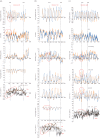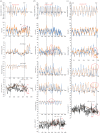Aerodynamics of manoeuvring flight in brown long-eared bats (Plecotus auritus)
- PMID: 30404906
- PMCID: PMC6283987
- DOI: 10.1098/rsif.2018.0441
Aerodynamics of manoeuvring flight in brown long-eared bats (Plecotus auritus)
Abstract
In this study, we explicitly examine the aerodynamics of manoeuvring flight in animals. We studied brown long-eared bats flying in a wind tunnel while performing basic sideways manoeuvres. We used particle image velocimetry in combination with high-speed filming to link aerodynamics and kinematics to understand the mechanistic basis of manoeuvres. We predicted that the bats would primarily use the downstroke to generate the asymmetries for the manoeuvre since it has been shown previously that the majority of forces are generated during this phase of the wingbeat. We found instead that the bats more often used the upstroke than they used the downstroke for this. We also found that the bats used both drag/thrust-based and lift-based asymmetries to perform the manoeuvre and that they even frequently switch between these within the course of a manoeuvre. We conclude that the bats used three main modes: lift asymmetries during downstroke, thrust/drag asymmetries during downstroke and thrust/drag asymmetries during upstroke. For future studies, we hypothesize that lift asymmetries are used for fast turns and thrust/drag for slow turns and that the choice between up- and downstroke depends on the timing of when the bat needs to generate asymmetries.
Keywords: aerodynamics; bats; kinematics; manoeuvring flight; particle image velocimetry.
© 2018 The Author(s).
Conflict of interest statement
We declare we have no competing interests.
Figures





Similar articles
-
Ear-body lift and a novel thrust generating mechanism revealed by the complex wake of brown long-eared bats (Plecotus auritus).Sci Rep. 2016 Apr 27;6:24886. doi: 10.1038/srep24886. Sci Rep. 2016. PMID: 27118083 Free PMC article.
-
Bat flight: aerodynamics, kinematics and flight morphology.J Exp Biol. 2015 Mar;218(Pt 5):653-63. doi: 10.1242/jeb.031203. J Exp Biol. 2015. PMID: 25740899 Review.
-
Aerodynamics, kinematics, and energetics of horizontal flapping flight in the long-eared bat Plecotus auritus.J Exp Biol. 1976 Aug;65(1):179-212. doi: 10.1242/jeb.65.1.179. J Exp Biol. 1976. PMID: 993701
-
Body lift, drag and power are relatively higher in large-eared than in small-eared bat species.J R Soc Interface. 2017 Oct;14(135):20170455. doi: 10.1098/rsif.2017.0455. J R Soc Interface. 2017. PMID: 29070593 Free PMC article.
-
Flapping wing aerodynamics: from insects to vertebrates.J Exp Biol. 2016 Apr;219(Pt 7):920-32. doi: 10.1242/jeb.042317. J Exp Biol. 2016. PMID: 27030773 Review.
Cited by
-
Downstroke and upstroke conflict during banked turns in butterflies.J R Soc Interface. 2021 Dec;18(185):20210779. doi: 10.1098/rsif.2021.0779. Epub 2021 Dec 1. J R Soc Interface. 2021. PMID: 34847788 Free PMC article.
-
Turning-ascending flight of a Hipposideros pratti bat.R Soc Open Sci. 2022 Jun 8;9(6):211788. doi: 10.1098/rsos.211788. eCollection 2022 Jun. R Soc Open Sci. 2022. PMID: 35706670 Free PMC article.
-
Maneuvering Characteristics of Bilateral Amplitude-Asymmetric Flapping Motion Based on a Bat-Inspired Flexible Wing.Biomimetics (Basel). 2024 Feb 29;9(3):148. doi: 10.3390/biomimetics9030148. Biomimetics (Basel). 2024. PMID: 38534833 Free PMC article.
-
Lessons from natural flight for aviation: then, now and tomorrow.J Exp Biol. 2023 Apr 25;226(Suppl_1):jeb245409. doi: 10.1242/jeb.245409. Epub 2023 Apr 17. J Exp Biol. 2023. PMID: 37066792 Free PMC article. Review.
-
Analysis of a 180-degree U-turn maneuver executed by a hipposiderid bat.PLoS One. 2020 Nov 3;15(11):e0241489. doi: 10.1371/journal.pone.0241489. eCollection 2020. PLoS One. 2020. PMID: 33141874 Free PMC article.
References
-
- Baker PS. 1959. The wing movements of flying locusts during steering behavior. J. Comp. Physiol. 131, 49–58. (10.1007/BF00613083) - DOI
-
- Robertson RM, Johnson AG. 1993. Collision avoidance of flying locusts: steering torques and behavior. J. Exp. Biol. 183, 35–60.
-
- Balint CN, Dickinson MH. 2001. The correlation between wing kinematics and steering muscle activity in the blowfly Calliphora vicina. J. Exp. Biol. 204, 4213–4226. - PubMed
Publication types
MeSH terms
LinkOut - more resources
Full Text Sources
Other Literature Sources

